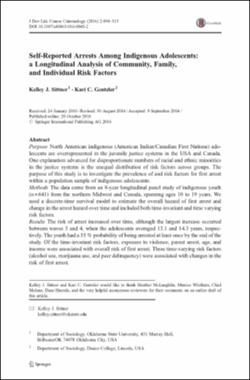| dc.contributor.author | Sittner, Kelley J. | |
| dc.contributor.author | Gentzler, Kari C. | |
| dc.date.accessioned | 2022-02-15T20:43:42Z | |
| dc.date.available | 2022-02-15T20:43:42Z | |
| dc.date.issued | 2016 | |
| dc.identifier | oksd_sittner_selfreportedarrests_2016 | |
| dc.identifier.citation | Sittner, K. J., & Gentzler, K. C. (2016). Self-reported arrests among Indigenous adolescents: A longitudinal analysis of community, family, and individual risk factors. Journal of Developmental and Life-Course Criminology, 2(4), pp. 494-515. https://doi.org/10.1007/s40865-016-0045-2 | |
| dc.identifier.uri | https://hdl.handle.net/11244/334615 | |
| dc.description.abstract | Purpose: North American indigenous (American Indian/Canadian First Nations) adolescents are overrepresented in the juvenile justice systems in the USA and Canada. One explanation advanced for disproportionate numbers of racial and ethnic minorities in the justice systems is the unequal distribution of risk factors across groups. The purpose of this study is to investigate the prevalence of and risk factors for first arrest within a population sample of indigenous adolescents. | |
| dc.description.abstract | Methods: The data come from an 8-year longitudinal panel study of indigenous youth (n = 641) from the northern Midwest and Canada, spanning ages 10 to 19 years. We used a discrete-time survival model to estimate the overall hazard of first arrest and change in the arrest hazard over time and included both time-invariant and time varying risk factors. | |
| dc.description.abstract | Results: The risk of arrest increased over time, although the largest increase occurred between waves 3 and 4, when the adolescents averaged 13.1 and 14.3 years, respectively. The youth had a 55% probability of being arrested at least once by the end of the study. Of the time-invariant risk factors, exposure to violence, parent arrest, age, and income were associated with overall risk of first arrest. Three time-varying risk factors (alcohol use, marijuana use, and peer delinquency) were associated with changes in the risk of first arrest. | |
| dc.description.abstract | Conclusions: Being arrested carries significant repercussions for young people, including involvement in the juvenile justice system as well as consequences into adulthood. Communities must go beyond programs that target problem behaviors because community, family, and peer factors are also important. | |
| dc.format | application/pdf | |
| dc.language | en_US | |
| dc.publisher | Springer Science and Business Media LLC | |
| dc.relation.ispartof | Journal of Developmental and Life-Course Criminology, 2 (4) | |
| dc.relation.uri | https://www.ncbi.nlm.nih.gov/pubmed/29503797 | |
| dc.rights | This material has been previously published. In the Oklahoma State University Library's institutional repository this version is made available through the open access principles and the terms of agreement/consent between the author(s) and the publisher. The permission policy on the use, reproduction or distribution of the material falls under fair use for educational, scholarship, and research purposes. Contact Digital Resources and Discovery Services at lib-dls@okstate.edu or 405-744-9161 for further information. | |
| dc.subject | American Indian | |
| dc.subject | Arrest | |
| dc.subject | Hazard Analysis | |
| dc.subject | Self-report | |
| dc.title | Self-reported arrests among Indigenous adolescents: A longitudinal analysis of community, family, and individual risk factors | |
| dc.date.updated | 2022-02-09T17:52:34Z | |
| osu.filename | oksd_sittner_selfreportedarrests_2016.pdf | |
| dc.description.peerreview | Peer reviewed | |
| dc.identifier.doi | 10.1007/s40865-016-0045-2 | |
| dc.description.department | Sociology | |
| dc.type.genre | Article | |
| dc.type.material | Text | |
| dc.relation.oaurl | https://pubmed.ncbi.nlm.nih.gov/29503797/ | |
| dc.identifier.author | ORCID: 0000-0002-8588-4487 (Sittner, KJ) | |
| dc.identifier.author | ScopusID: 55189348500 | 57195727690 (Sittner, KJ) | |
| dc.identifier.author | ScopusID: 55368161800 (Gentzler, KC) | |
